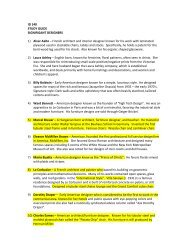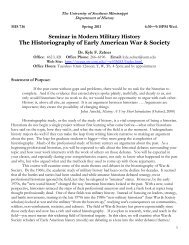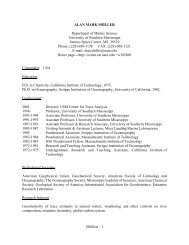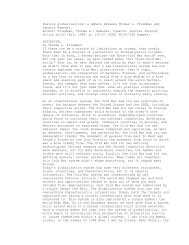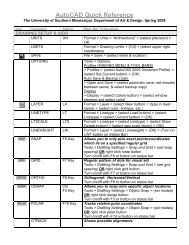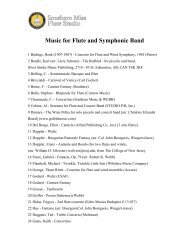Get PDF (1214K) - Wiley Online Library
Get PDF (1214K) - Wiley Online Library
Get PDF (1214K) - Wiley Online Library
You also want an ePaper? Increase the reach of your titles
YUMPU automatically turns print PDFs into web optimized ePapers that Google loves.
RESEARCH ARTICLE<br />
Characterization and localization of Rickettsia sp. in water beetles of<br />
genus Deronectes (Coleoptera: Dytiscidae)<br />
Stefan Martin Küchler, Siegfried Kehl & Konrad Dettner<br />
Department of Animal Ecology II, University of Bayreuth, Bayreuth, Germany<br />
Correspondence: Stefan Martin Küchler,<br />
Department of Animal Ecology II, University of<br />
Bayreuth, Universitätsstraße 30, 95440<br />
Bayreuth, Germany. Tel.: 10049 0921 55<br />
2733; fax: 10049 0921 55 2743; e-mail:<br />
stefan.kuechler@uni-bayreuth.de<br />
Received 22 September 2008; revised 3<br />
February 2009; accepted 3 February 2009.<br />
First published online 16 March 2009.<br />
DOI:10.1111/j.1574-6941.2009.00665.x<br />
Editor: Michael Wagner<br />
Keywords<br />
Rickettsia; Deronectes; Dytiscidae; citrate<br />
synthase; electron microscopy.<br />
Abstract<br />
In the present study, Rickettsia sp. was detected in four water beetles of the genus<br />
Deronectes (Dytiscidae) for the first time. Rickettsiae were found in 100% of<br />
examined specimens of Deronectes platynotus (45/45), 39.4% of Deronectes aubei<br />
(28/71), 40% of Deronectes delarouzei (2/5) and 33.3% of Deronectes semirufus<br />
(1/3). Analysis of 16S rRNA gene sequences revealed a phylogenetic relationship<br />
with rickettsial isolates of Limonia chorea (Diptera), tentatively classified as<br />
members of the basal ancestral group. Phylogenetic analysis of the gltA (citrate<br />
synthase) gene sequences showed that Deronectes symbionts were closest to<br />
bacterial symbionts from spiders. Ultrastructural examinations revealed typical<br />
morphological features and intracellular arrangements of rickettsiae. The distribution,<br />
transmission and localization of Rickettsia sp. in D. platynotus were studied<br />
using a diagnostic PCR assay and FISH. Eggs from infected females of D. platynotus<br />
were all Rickettsia-positive, indicative of a vertical transmission.<br />
Introduction<br />
Gram-negative bacteria of the genus Rickettsia belong to the<br />
family Rickettsiaceae in the subdivision of the monophyletic<br />
order Rickettsiales (Alphaproteobacteria). All members of the<br />
genus Rickettsia are obligate intracellular bacteria that reside<br />
free in the cytoplasm of eukaryotic cells. Mostly known<br />
as pathogenic endosymbionts of arthropods (ticks, mites,<br />
fleas and lice), rickettsiae cause human and animal diseases<br />
with a worldwide distribution (Eremeeva & Dasch, 2000).<br />
Some species are also capable of infecting and causing<br />
disease in plants (Davis et al., 1998). Rickettsiae are usually<br />
transmitted by arthropods to vertebrates via feces or salivary<br />
secretions. Because of their considerable medical importance,<br />
the genus Rickettsia was traditionally divided into two<br />
groups (Weiss & Moulder, 1984): the spotted fever group,<br />
including Rickettsia rickettsii and allied species, causative<br />
agents of spotted fever; and the typhus group, including<br />
Rickettsia prowazekii and Rickettsia typhi, the agents of<br />
murine and endemic typhus, respectively. In recent years,<br />
new rickettsiae have been discovered that do not belong to<br />
the previously described subgroups. A third group named<br />
‘ancestral group’, partially subdivided into the bellii, leech<br />
and limoniae groups (Perlman et al., 2006; Perotti et al.,<br />
2006), was established (Stothard & Fuerst, 1995; Fournier &<br />
Raoult, 2007), and consists of Rickettsia bellii, Rickettsia<br />
canadensis and additional numerous rickettsial isolates that<br />
have been isolated from different terrestrial arthropods such<br />
as whiteflies, flies, aphids and beetles (Chen et al., 1996;<br />
Fukatsu et al., 2000; Campbell et al., 2004; Gottlieb et al.,<br />
2006; Zchori-Fein et al., 2006). The ancestral group is still an<br />
initial theoretical classification that is not based on<br />
morphological criteria or biochemical features concerning<br />
basal standing rickettsial isolates in the genus. Rickettsiae of<br />
the ancestral group were not shown to be pathogens for<br />
humans or their animal hosts. However, insects are not the<br />
only vector of rickettsiae. Recently, rickettsiae have been<br />
found in spider mite Tetranychus urticae (Hoy & Jeyaprakash,<br />
2005), various spider species (Goodacre et al., 2006),<br />
amoeba Nuclearia pattersoni (Dykova et al., 2003), marine<br />
ciliate Diophrys appendiculata (Vannini et al., 2005) and<br />
several leeches from freshwater environments (Kikuchi et al.,<br />
2002; Kikuchi & Fukatsu, 2005), which also cluster into the<br />
ancestral group. Analyses of 16S rRNA genes suggest that<br />
many of these rickettsial isolates could represent new genera<br />
within the order Rickettsiales. As already supposed (Yu &<br />
Walker, 2006), the family Rickettsiaceae could be more<br />
widespread than observed so far.<br />
FEMS Microbiol Ecol 68 (2009) 201–211<br />
c 2009 Federation of European Microbiological Societies<br />
Published by Blackwell Publishing Ltd. All rights reserved
202 S.M. Küchler et al.<br />
The purpose of this study was to investigate and identify<br />
symbiotic bacteria in selected water beetles of the palaearctic<br />
genus Deronectes. The association of endosymbiotic bacteria<br />
with water insects, especially water beetles, was already<br />
presumed in previous studies (Maddison et al., 1999; Shull<br />
et al., 2001). Representatives of the genus Deronectes are<br />
predacious and colored uniformly black or brown. Deronectes<br />
species usually live among gravel in small, swift or<br />
strongly flowing streams with sparse vegetation. Most<br />
species prefer mountainous regions, some occurring at a<br />
high altitude. To date 55 species have been described (Fery &<br />
Brancucci, 1997; Fery et al., 2001).<br />
In the present molecular study, we report the first finding<br />
of a coccobacillus bacterium in Deronectes, which could be<br />
identified as a member of the genus Rickettsia. A total of 136<br />
specimens from seven Deronectes species were examined for<br />
the existence of Rickettsia sp. using a diagnostic PCR assay.<br />
Phylogenetic analysis inferred by 16S rRNA gene and<br />
particularly the rickettsial gltA (citrate synthase) gene<br />
disclosed the phylogenetic position of beetle Rickettsia in<br />
the existing phylogenetic system of Rickettsia endosymbionts.<br />
FISH was used for the investigation of rickettsial<br />
distribution and vertical transmission rates. The morphological<br />
characteristics of the bacterium were analyzed by<br />
electron microscopic observations.<br />
Materials and methods<br />
Samples<br />
A total of 136 Deronectes specimens were collected between<br />
2003 and 2008 (Table 1) by kick-sampling (Schwoerbel,<br />
1994). Deronectes platynotus and Deronectes latus were<br />
obtained from Fichtelgebirge, a mountain range in northeastern<br />
Bavaria, Germany. Deronectes aubei was collected<br />
from Black Forest (Germany), Italy and French alps. Deronectes<br />
delarouzei, Deronectes semirufus, D. aubei sanfilippoi<br />
and Deronectes moestus inconspectus came from Spain, Italy<br />
and France. Beetles were brought to laboratory alive and<br />
embedded for histology/FISH or dissected for diagnostic<br />
PCR immediately.<br />
Histology<br />
Before all the beetles were fixed in 4% paraformaldehyde<br />
overnight, the elytra were carefully removed. The fixed<br />
beetles were washed in 1 phosphate-buffered saline and<br />
96% ethanol (1 : 1), dehydrated serially in ethanol (70%,<br />
90%, 2 100%) and embedded in UNICRYL TM (Plano<br />
GmbH, Germany). Serial sections (2 mm) were cut using a<br />
Leica Jung RM2035 rotary microtome (Leica Instruments<br />
GmbH, Germany), mounted on epoxy-coated glass slides<br />
and subjected to FISH.<br />
DNA extraction, cloning and sequencing<br />
DNA was extracted using a QUIAGEN DNeasy s Tissue Kit<br />
(QUIAGEN GmbH, Germany) following the protocol for<br />
animal tissue. The eubacterial 16S rRNA gene was PCR<br />
amplified using the primer set 07F (5 0 -AGAGTTT<br />
GATCMTGGCTCAG-3 0 ) and 1507R (5 0 -TACCTTGTTAC<br />
GACTTCAC-3 0 ) (Lane, 1991). All PCR reactions were<br />
performed in a Biometra thermal cycler with the following<br />
program: an initial denaturating step at 94 1C for 3 min,<br />
followed by 34 cycles of 94 1C for 30 s, 50 1C for 2 min and<br />
72 1C for 1 min. A final extension step of 72 1C for 10 min<br />
was included. PCR products of the expected sizes were<br />
cloned using the TOPO TA Cloning s Kit (Invitrogen, CA).<br />
Suitable clones for sequencing were selected by restriction<br />
fragment length polymorphism (RFLP). Inserts were digested<br />
by restriction endonucleases HaeIII and TaqI. Plasmids<br />
containing the DNA inserts of the expected sizes were<br />
sequenced at the DNA analytics core facility of the<br />
Table 1. Infection rates of Rickettsia sp. in natural populations of Deronectes spp.<br />
Species Locality Date of collection<br />
No. of<br />
individuals<br />
% of infection<br />
(infected/total)<br />
D. platynotus Fichtelgebirge, Bavaria, Germany 2007/2008 45 100 (45/45)<br />
D. aubei Black Forest, Germany, Italy, France 2003–2008 71 39.4 (28/71)<br />
D. latus Fichtelgebirge, Bavaria, Germany 17.10.2007 7 0 (0/7)<br />
D. delarouzei Bonansa, El pont de Suert, Spain 05.10.2007 2<br />
Llesp, El pont de Suert, Spain 10.08.2004 1 40 (2/5)<br />
05.10.2007 1<br />
Saldes, Spain 05.10.2007 1<br />
D. semirufus Grotta all’Onda, Casoli, Lucca, Tuscany, Italy 09.10.2003 1<br />
Sospel, Moulinet, Apuane-Maritimes, France 07.10.2003 1 33.3 (1/3)<br />
Fociomboli, Apuane Alps, Italy 07.09.2007 1<br />
D. aubei sanfilippoi Vernet les Bains, Pyr. Orientales, France 07.10.2007 3 0 (0/3)<br />
D. moestus inconspectus Saldes, Spain 17.10.2007 2 0 (0/2)<br />
c 2009 Federation of European Microbiological Societies<br />
Published by Blackwell Publishing Ltd. All rights reserved<br />
FEMS Microbiol Ecol 68 (2009) 201–211
Rickettsia endosymbiont in water beetles<br />
203<br />
University of Bayreuth with M13 forward and M13 reverse<br />
sequencing primers (Invitrogen).<br />
For diagnostic PCR, the 16S rRNA gene was amplified using<br />
the Rickettsia-specific primers Ri_170F (5 0 -GGGCTTGCTCTA<br />
AATTAGTTAGT-3 0 ) and Ri_1500R (5 0 -ACGTTAGCTCACC<br />
ACCTTCAGG-3 0 ). The citrate synthase gene (gltA) wasdetected<br />
using the primers CS5_F (5 0 -TCTTTATGGGGACC<br />
AGCC-3 0 )andCS4_R(5 0 -TTTCCATTGTGCCATCCAG-3 0 ).<br />
PCR primers were designed using the probe design tool of the<br />
ARB software package (Ludwig et al., 2004). Diagnostic PCR<br />
was performed under the temperature profile described above.<br />
FISH<br />
The following probes were used for FISH targeted to the 16S<br />
rRNA gene: eubacterial probe EUB338 [5 0 -(Cy5)-GCTGCCT<br />
CCCGTAGGAGT-3 0 ](Amannet al., 1995), EUB388 II [5 0 -<br />
(Cy3)-GCAGCCACCCGTAGGTGT-3 0 ], EUB338 III [5 0 -(Cy3)-<br />
GCTGCCACCCGTAGGTGT-3 0 ] (Daims et al., 1999) and<br />
Rickettsia-specific probe Rick_B1 [5 0 -(Cy3)-CCATCATCCC<br />
CTACTACA-3 0 ] (Perotti et al., 2006). Additionally, a nonsense<br />
probe complementary to EUB338, NON338 [5 0 -(Cy3)-<br />
ACTCCTACGGGAGGCAGC-3 0 ] (Manz et al., 1992) was<br />
used as a negative control of the hybridization protocol.<br />
Slides were hybridized in hybridization buffer [20 mM Tris-<br />
HCl (pH 8.0), 0.9 M NaCl, 0.01% sodium dodecyl sulfate<br />
(SDS), and 20% formamide] containing 10 pmol of fluorescent<br />
probes per milliliter, incubated at 46 1C for 90 min,<br />
rinsed in washing buffer [20 mM Tris-HCl (pH 8.0),<br />
225 mM NaCl, 5 mM EDTA, and 0.01% SDS], mounted<br />
with antibleaching solution (VECTASHIELD s Mounting<br />
Medium; Vector Laboratories, UK) and viewed under a<br />
fluorescent microscope.<br />
Electron microscopy<br />
Male accessory glands of D. platynotus were fixed in 2.5%<br />
glutaraldehyde in 0.1 M cacodylate buffer (pH 7.3) for 1 h,<br />
embedded in 2% agarose and fixed again in 2.5% glutaraldehyde<br />
in 0.1 M cacodylate buffer (pH 7.3) overnight.<br />
Specimens were washed in 0.1 M cacodylate three times for<br />
20 min. Following postfixation in 2% osmium tetroxide for<br />
2 h, the specimens were washed and stained en bloc in 2%<br />
uranyl acetate for 90 min. After fixation, specimens were<br />
dehydrated serially in ethanol (30%, 50%, 70%, 95% and<br />
3 100%), transferred to propylene oxide and embedded in<br />
Epon. Ultrathin sections (70 nm) were cut with a diamond<br />
knife (MicroStar, Huntsville, TX) on a Leica Ultracut UCT<br />
microtome (Leica Microsystems, Vienna, Austria). Ultrathin<br />
sections were mounted on pioloform-coated copper<br />
grids, and stained with saturated uranyl acetate, followed by<br />
lead citrate. The sections were viewed with a Zeiss CEM 902<br />
A transmission electron microscope (Carl Zeiss, Oberkochen,<br />
Germany) at 80 kV. Micrographs were taken using an<br />
SO-163 EM film (Eastman Kodak, Rochester, NY).<br />
Phylogenetic analysis<br />
High-quality sequences of the 16S rRNA gene and the gltA<br />
gene for citrate synthase were aligned with the CLUSTALW<br />
software in BIOEDIT (Hall, 1999) and transferred to the ARB<br />
software package and edited manually. Phylogenetic analyses<br />
using maximum parsimony were performed using<br />
PAUP version 4.0b10 (Swofford, 2000). The heuristic<br />
search included 10 000 random addition replicates and tree<br />
bissection–reconnection (TBR) branch swapping with the<br />
Multrees option. A 50% majority-rule consensus tree of the<br />
most parsimonious tree was constructed and exported to<br />
ARB program package, where branch lengths were calculated.<br />
Bootstrap analyses were performed with 500 replicates<br />
with TBR branch swapping, 25 random addition replicates<br />
and the Multrees option in PAUP . The gltA citrate<br />
synthase sequences were checked for chimeras using<br />
CCODE (Gonzalez et al., 2005).<br />
Sequence data<br />
Clone sequences of 16S rRNA gene and gltA sequences for the<br />
D. platynotus-, D. aubei-, D. semirufus- andD. delarouzeiassociated<br />
Rickettsia sp. were deposited in the DDBJ/EMBL/<br />
GenBank nucleotide sequence databases with the accession<br />
numbers FM177868–FM177878 and FM955310–FM955315,<br />
respectively.<br />
Results<br />
Identification of bacterial symbiont<br />
A 1.5-kb segment of the eubacterial 16S rRNA gene was<br />
amplified by PCR and was subjected to cloning and RFLP<br />
typing. Overall, 19 clones were sequenced and compared with<br />
other sequences found in GenBank. The nucleotide sequences<br />
of clones exhibited 99% similarity to the sequence of Rickettsia<br />
limoniae (AF322442, AF322443) from cranefly L. chorea<br />
(Diptera, Limoniidae). The validity of the sequences was<br />
confirmed by FISH performed with probe Rick_B1. Furthermore,<br />
we sequenced a 416-bp fragment of the gltA gene<br />
(citrate synthase) from four Rickettsia-positive D. platynotus<br />
beetles as well as from D. aubei (404 bp), D. semirufus<br />
(367 bp) and D. delarouzei (401 bp). The gltA sequences from<br />
D. platynotus rickettsiae were 100% identical to rickettsial<br />
isolate (DQ 231491) from spider Pityophantes phrygianus<br />
(Goodacre et al., 2006). The gltA gene sequences from<br />
rickettsial symbionts of D. aubei and D. delarouzei exhibited<br />
99% similarity to the sequence of P. phrygianus, whereas<br />
rickettsial gltA sequences from D. semirufus showed 98%<br />
similarity to Rickettsia endosymbionts of spider Meta menegi.<br />
FEMS Microbiol Ecol 68 (2009) 201–211<br />
c 2009 Federation of European Microbiological Societies<br />
Published by Blackwell Publishing Ltd. All rights reserved
204 S.M. Küchler et al.<br />
Screening for the presence of Rickettsia sp.<br />
Six Deronectes species and one subspecies were examined<br />
using Rickettsia-specific primers in a diagnostic PCR assay<br />
(Table 1). A total of 45 D. platynotus were screened. Rickettsia<br />
sp. could be detected in 100% of all tested D. platynotus. In<br />
contrast, only 39.4% of 71 examined individuals of D. aubei<br />
were infected. Both species were collected in different seasons<br />
and populations. Just two individuals of D. delarouzei and<br />
one individual of D. semirufus werefoundtobepositivefor<br />
the Rickettsia symbiont. For elaboration of infection rates in<br />
these two species, more specimens from different populations<br />
have to be examined for rickettsiae. No rickettsiae were<br />
detected in seven individuals of D. latus. In the same way,<br />
three surveys of D. aubei sanfilippoi indicated a negative signal<br />
for Rickettsia. Two examined individuals of D. moestus<br />
inconspectus also did not show any infection of Rickettsia.<br />
However, only a few individuals of D. latus, D. aubei<br />
sanfilippoi and D. moestus inconspectus could be examined<br />
for the presence of rickettsiae. All examined species of<br />
D. platynotus and D. aubei exhibited a well-balanced sex ratio.<br />
Furthermore, there was no evidence for male killing, parthenogenesis<br />
or other sex ratio distortion in numerically examined<br />
species of D. platynotus and D. aubei. Currentstudies<br />
indicated that further water beetles are associated with<br />
Rickettsia sp. too (data not shown). Examined species of<br />
Agabus melanarius, Agabus wasastjernae, Agabus guttatus,<br />
Hydroporus gyllenhalii, Hydroporus tristis, Hydroporus umbrosus<br />
and Hydroporus obscurus also exhibited Rickettsia infections.<br />
In situ hybridization of Rickettsia symbiont<br />
FISH revealed a remarkable affection of the Rickettsia<br />
symbiont (Fig. 1a). All tissues that are in contact with the<br />
hemolymph are affected by rickettsiae. The symbionts could<br />
be identified in all compartments of Deronectes, including<br />
the head (ommatidia) (Fig. 1b) and legs. Actually, internal<br />
parts of elytra with soft tissue exhibited bacteria. Especially,<br />
numerous rickettsiae could be detected in tissue of active<br />
metabolism, such as the fatbody and internal reproduction<br />
organs. A lower number of rickettsiae was found in muscles.<br />
In addition, Rickettsia sp. is more abundant in females than<br />
males. Accessory glands of males will be affected predominantly<br />
(Fig. 1c). The strongest signals of a Rickettsia-specific<br />
probe were found in females of D. platynotus. Minor signals<br />
of symbionts were detected in D. aubei, D. semirufus and<br />
D. delarouzei (data not shown).<br />
The distribution of the Rickettsia was also investigated in<br />
eggs and larvae of D. platynotus. The presence of large<br />
numbers of symbionts in oocytes and follicle cells (Fig. 1d),<br />
and the detection of Rickettsia in eggs (Fig. 1e) are indicative<br />
of the vertical transmission of symbionts. In the second and<br />
third larval stages of Deronectes, rickettsiae could be detected<br />
in the entire body. The number of symbionts increased from<br />
stage to stage.<br />
Fig. 1. FISH with specific probe Rick_B1 (Cy3) of<br />
square sections of water beetle Deronectes<br />
platynotus adults. (a) Rickettsia sp. infection of<br />
fatbody in a female abdomen. Scale bar = 40 mm.<br />
(b) Square section of head; numerous Rickettsia<br />
signals from ommatidia (arrows). Rickettsia sp.<br />
clustered around the cerebral ganglia. Scale<br />
bar = 40 mm. (c) Male accessory glands infected<br />
by intracytosolic Rickettsia sp. Bacteria are<br />
located near the connective tissue (arrow). Scale<br />
bar = 20 mm. (d) Ovariole infected by Rickettsia<br />
sp. symbiont. Scale bar = 20 mm. (e) Bacterial<br />
symbionts are also present within the egg<br />
(arrow). Surrounding tissue of ovarioles habouring<br />
Rickettsia. Scale bar = 50 mm. FB, fat body;<br />
B, brain; E, egg; AGT, accessory glandular tissue;<br />
M, muscle; O, ovariole; OM, ommatidia. (a), (b)<br />
and (c) were taken by confocal microscope.<br />
(d) and (e) were taken by a conventional<br />
fluorescence microscope.<br />
c 2009 Federation of European Microbiological Societies<br />
Published by Blackwell Publishing Ltd. All rights reserved<br />
FEMS Microbiol Ecol 68 (2009) 201–211
Rickettsia endosymbiont in water beetles<br />
205<br />
Fig. 2. FISH double hybridization of the<br />
Rickettsia symbiont on tissue (fatbody) crosssection<br />
from Deronectes platynotus (a–c, scale<br />
bar = 40 mm) and Deronectes aubei (d–f, scale<br />
bar = 20 mm). The left panels (a, d) show FISH<br />
with the probe Cy3-Rick_B1, which visualizes the<br />
Rickettsia symbiont, while middle panels (b, e)<br />
show FISH with the probe Cy5-EUB338, which<br />
recognizes diverse eubacteria universally. The<br />
overlay (c, f) does not show other bacteria.<br />
Double hybridization performed with Rick_B1, together<br />
with the universal probe EUB338, showed the absence of any<br />
other kind of endosymbiotic bacteria (Fig. 2), with the<br />
exception of gut bacteria inside adult and larval specimens<br />
of Deronectes. FISH accomplished with EUB388 II and<br />
EUB338 III did not show any positive signals (data not<br />
shown).<br />
Electron microscopy of the Rickettsia symbiont<br />
Ultrastructural examinations of male accessory glands of<br />
D. platynotus revealed coccobacillary rickettsiae that were<br />
observed free in the cytoplasm (Fig. 3a). Most rickettsiae<br />
ranged from 0.35 mm in width to 0.65 mm in length. Rickettsiae<br />
were delineated by an inner periplasmatic membrane,<br />
a periplasmatic space and a trilaminar cell wall with a thicker<br />
inner leaflet, characteristic of the genus Rickettsia. ARickettsia-typical<br />
slime layer or an electron-translucent zone, up<br />
to 60 nm thick, surrounded the cell wall and separated the<br />
bacterium from the cytoplasm of the host cell (Fig. 3b).<br />
Isolated bacteria were also found in the musculature,<br />
enclosing the male accessory gland (Fig. 3c). Some of the<br />
symbionts were much longer and had a ‘filamentous’<br />
appearance. They could be as long as 2.74 mm (Fig. 3d).<br />
Phylogenetic analysis of the Rickettsia symbiont<br />
Phylogenetic analyses on the basis of the 16S rRNA gene<br />
sequence revealed that Rickettsia sp. from Deronectes belong<br />
neither to the ‘spotted fever group’ nor the ‘typhus group,’<br />
but was placed within the ancestral group (100% bootstrap<br />
support) (Fig. 4). Clones of the endosymbiotic bacteria of<br />
D. platynotus, D. aubei and D. delarouzei were placed in the<br />
clade with R. limoniae, Rickettsia endosymbionts of Cerobasis<br />
guestifalica (Psocoptera, Trogiidae) and Lutzomyia apache<br />
(Diptera, Psychodinae), whereas Rickettsia sp. of D. semirufus<br />
cluster basal with rickettsiae from leeches. By phylogenetic<br />
analysis based on the gltA gene (Fig. 5), the Rickettsia strain<br />
from Deronectes clustered with Rickettsia endosymbionts of<br />
L. apache and different spider species in a terminal group<br />
(99% bootstrap support) that is distinctly separated from<br />
other Rickettsia species of the spotted fever, typhus and bellii<br />
groups. The phylogenetic position of Deronectes rickettsiae<br />
was the same in the 16S rRNA gene and gltA trees when the<br />
maximum-likelihood, parsimony and distance methods<br />
were used (data not shown). Only the position of the<br />
Rickettsia endosymbiont of D. semirufus varied with different<br />
methods (MrBayes, data not shown), and was sometimes<br />
added to the leech group or to the other rickettsial<br />
endosymbionts of the Deronectes species of the limoniae<br />
group. This explains the low bootstrap support values<br />
in the ancestral group in the phylogenetic tree of 16S rRNA<br />
gene.<br />
Discussion<br />
The present study reports the first molecular identification<br />
of Rickettsia in four water beetle species of the genus<br />
Deronectes and generally for adephagan beetles. Evaluable<br />
results have been obtained of D. platynotus and D. aubei.<br />
Rickettsia infection was detected in 100% (45/45) of<br />
D. platynotus and 39.4% (28/71) of D. aubei. The frequencies<br />
of Rickettsia infection were maintained constant in<br />
different seasons. Individuals of D. delarouzei and D. semirufus<br />
were also tested positive for rickettsiae, whereas<br />
individuals of D. latus, D. aubei sanfilippoi and D. moestus<br />
inconspectus did not show any signal for symbiotic bacteria.<br />
Remarkably, Rickettsia-positive species of Deronectes do not<br />
cluster in a single group within the phylogenetic tree of<br />
Deronectes. In addition, the current analysis indicated six<br />
more species of Agabus and Hydroporus (Dytiscidae) that are<br />
FEMS Microbiol Ecol 68 (2009) 201–211<br />
c 2009 Federation of European Microbiological Societies<br />
Published by Blackwell Publishing Ltd. All rights reserved
206 S.M. Küchler et al.<br />
Fig. 3. Electron photomicrographs of male<br />
accessory gland tissue from water beetle<br />
Deronectes platynotus infected by intracytosolic<br />
Rickettsia sp. (a) Coccobacillary rickettsiae<br />
resided free in the cytoplasm of accessory gland<br />
tissue (asterisk), located near connective tissue<br />
(arrow), which close about the glandular tissue.<br />
Scale bar = 1.1 mm. (b) High magnification of<br />
Rickettsia sp. showing the typical rickettsial<br />
morphology, with a periplasmic membrane<br />
(white arrowhead), an electron-lucent<br />
periplasmic space (black arrowhead), the<br />
trilaminar cell wall (black arrow) and with an<br />
electron-lucent ‘halozone’ (asterisk). Scale<br />
bar = 0.09 mm. (c) Rickettsia within accessory<br />
gland musculature. Scale bar = 0.6 mm.<br />
(d) A filamentous Rickettsia (asterisk), possessing<br />
a length of 2.74 mm, before extending out of the<br />
plane of section (arrow). Scale bar = 0.4 mm.<br />
associated with Rickettsia sp. too. To our knowledge, only six<br />
verifications of Rickettsia have been documented in Coleoptera<br />
so far (Coccinellidae: Werren et al., 1994; von der<br />
Schulenburg et al., 2001; Bruchidae: Fukatsu et al., 2000;<br />
Buprestidae: Lawson et al., 2001; Curculionidae: Zchori-Fein<br />
et al., 2006; and Mordellidae: Duron et al., 2008). All<br />
rickettsial isolates from beetles, with the exception of<br />
Mordellistena sp., Adalia bipunctata and Adalia decempunctata,<br />
have been allocated to the rickettsial ancestral group,<br />
which includes all members of a clade that are most basal in<br />
the genus Rickettsia. Interestingly, the ancestral group comprised<br />
various symbionts from aquatic hosts, such as leeches<br />
(Kikuchi et al., 2002; Kikuchi & Fukatsu, 2005), amphizoic<br />
amoeba N. pattersoni (Dykova et al., 2003) and marine<br />
ciliate D. appendiculata (Vannini et al., 2005). Even insects<br />
that spend most of their development in water, i.e. the<br />
cranefly L. chorea (Diptera, Limoniidae; AF322443), mothfly<br />
L. apache (Diptera, Psychodidae; EU223247) and biting<br />
midge Culicoides sonorensis (Diptera, Ceratopogonidae)<br />
(Campbell et al., 2004), have been shown to be infected with<br />
rickettsiae. The exact classification of these rickettsial isolates<br />
that are allocated to the ancestral group is still unclear.<br />
Only 16S rRNA gene sequences are available for most<br />
members of the ancestral group. However, for detailed<br />
phylogenetic analysis within the genus Rickettsia, 16S rRNA<br />
gene sequences are not convenient because of their conservatism<br />
(Roux et al., 1997). Nevertheless, rickettsial 16S<br />
rRNA clone sequences from D. platynotus are different<br />
in two to six positions from each other, mainly in two<br />
variable regions. In all sequenced clones, the sequence<br />
similarity ranges from 99.1% to 100%. Possible reasons<br />
for the microdiversity of rickettsial 16S rRNA gene clones<br />
in D. platynotus may be the presence of multiple different<br />
copies of the 16S rRNA gene in one genome, which has<br />
been demonstrated for numerous species of bacteria (Cilia<br />
et al., 1996).<br />
c 2009 Federation of European Microbiological Societies<br />
Published by Blackwell Publishing Ltd. All rights reserved<br />
FEMS Microbiol Ecol 68 (2009) 201–211
Rickettsia endosymbiont in water beetles<br />
207<br />
Fig. 4. Phylogenetic position of different clones of the endosymbiotic bacteria of water beetles Deronectes platynotus, Deronectes aubei,<br />
Deronectes semirufus and Deronectes delarouzei (bold) based on 55 16S rRNA gene sequences (1350 bp, maximum parsimony heuristic search, 50%<br />
majority-rule consensus tree of 840 most parsimonious trees, tree length = 497, CI = 0.71, RI = 0.86). The tree has been rooted with Orientia<br />
tsutsugamushi as an outgroup. Only bootstrap values of at least 50% are shown at nodes (n = 500).<br />
FEMS Microbiol Ecol 68 (2009) 201–211<br />
c 2009 Federation of European Microbiological Societies<br />
Published by Blackwell Publishing Ltd. All rights reserved
208 S.M. Küchler et al.<br />
Fig. 5. Phylogenetic position of the endosymbiotic bacteria of water beetles Deronectes platynotus, Deronectes aubei, Deronectes semirufus and<br />
Deronectes delarouzei (bold) based on 46 gltA gene sequences (275 bp, maximum parsimony heuristic search, 50% majority-rule consensus tree of 30<br />
most parsimonious trees, tree length = 459, CI = 0.55, RI = 0.88). The tree has been rooted with Rhodopirellula baltica as an outgroup. Only bootstrap<br />
values of at least 50% are shown at nodes (n = 500).<br />
c 2009 Federation of European Microbiological Societies<br />
Published by Blackwell Publishing Ltd. All rights reserved<br />
FEMS Microbiol Ecol 68 (2009) 201–211
Rickettsia endosymbiont in water beetles<br />
209<br />
Referred to rickettsiae of the ancestral group, the citrate<br />
synthase-coding gltA gene sequences, also used for phylogenetic<br />
analysis, are only available for Rickettsia sp. of L. apache<br />
(EU368001) and rickettsial isolates from spiders (Goodacre<br />
et al., 2006). Sequences of further protein-coding genes,<br />
mostly those belonging to the surface cell antigen (sca)<br />
family, which have been used for the classification of<br />
rickettsial isolates over the past few years (Fournier et al.,<br />
1998; Roux & Raoult, 2000; Sekeyova et al., 2001; Ngwamidiba<br />
et al., 2006), are not available for rickettsiae of the<br />
ancestral group (Fournier et al., 2003).<br />
Phylogenetic analysis based on the 16S rRNA gene<br />
showed that Rickettsia sp. from Deronectes cluster into the<br />
‘limoniae group’, the basal subgroup of the ancestral group.<br />
Furthermore, we succeeded in partial sequencing of the gltA<br />
gene of these rickettsiae. Sequences from Deronectes symbionts<br />
resulted in a high concordance with rickettsial<br />
isolates from spiders P. phrygianus and M. mengei (Goodacre<br />
et al., 2006). However, 16S rRNA gene sequences are not<br />
available for spider rickettsiae in GenBank. It is interesting<br />
that sequences of the gltA gene of Rickettsia sp. isolated from<br />
water beetles are quite divergent from all previous valid<br />
Rickettsia strains from the spotted fever, typhus and bellii<br />
groups. Furthermore, gltA sequences of Rickettsia sp. show a<br />
high similarity to the related genus Bartonella, whose<br />
members are known as emerging human pathogens (Minnick<br />
& Anderson, 2006), but do not cluster with Bartonella<br />
sequences. Goodacre et al. (2006) presumed that spiderspecific<br />
Rickettsia form an isolated, terminal group that<br />
contains no symbionts of other arthropod hosts. They<br />
further assumed that frequent horizontal transmission of<br />
rickettsiae between spiders and their insect prey is unlikely<br />
because this would produce a heterogeneous assortment of<br />
non-spider-specific Rickettsia in spiders. In contrast, we were<br />
able to connect molecular data of the 16S rRNA gene<br />
sequences from basal rickettsiae strains and spider-specific<br />
Rickettsia by sequencing of 16S rRNA and gltA genes of the<br />
Deronectes symbiont. We assume that other Rickettsia strains<br />
of the ancestral group could exhibit comparable gltA<br />
sequences. Based on this assumption, Rickettsia from water<br />
beetles and spiders could belong to a new taxon, which might<br />
represent a near relative of the genus Rickettsia. Itcanbe<br />
speculated that sequences of the ompA, ompB genes and gene<br />
D will show appreciable deviations like gltA, if these genes are<br />
present in rickettsiae of the ancestral group in general.<br />
However, ultrastructural observations revealed typical<br />
morphological features and intracellular arrangements of<br />
rickettsiae, such as a thickened inner leaflet or electronlucent<br />
‘halos’ (Silverman, 1991). Additionally, some rickettsiae<br />
had a ‘filamentous’ appearance, similar to R. bellii<br />
from Amblyomma cooperi ticks (Labruna et al., 2004). The<br />
actual length of these bacteria cells could not be revealed by<br />
transmission electron microscopical sections.<br />
Furthermore, Rickettsia could be detected in all tissues of<br />
all investigated Rickettsia-positive Deronectes species. Presumably,<br />
symbionts have been transported by the hemolymph,<br />
comparable to observations in aphids (Chen et al.,<br />
1996). This would support their appearance in the eyes and<br />
legs. However, there is no evidence of harboring of Rickettsia<br />
in specific sheath cells, secondary mycetocytes or mycetomelike<br />
structures in aphids or booklice (Sakurai et al., 2005;<br />
Perotti et al., 2006). Likewise, Rickettsia could not be<br />
detected in high densities close to midgut epithelia or<br />
malpighian tubules (Perotti et al., 2006). In contrast, the<br />
internal genitals and fatbody exhibited numerous symbionts.<br />
Rickettsiae depend on precursors of amino acids<br />
from their host. Equally, the de novo synthesis of purines as<br />
well as pyrimidine is not achieved by rickettsiae (Renesto<br />
et al., 2005). Hence, tissue of high metabolic activity, such as<br />
the fatbody, could be preferably infested with Rickettsia. The<br />
presence of bacteria within ovariols and eggs also indicates<br />
strong evidence for transovarial transmission, which must<br />
contribute to the maintenance of Rickettsia sp. infection in<br />
Deronectes populations (Whitworth et al., 2003). This is<br />
supported by the existence of Rickettsia sp. in the second and<br />
third larval stages of Deronectes, whereas the quantity of<br />
symbionts increased gradually in each stage.<br />
Thus, the amount of bacteria seems to be determined by<br />
several factors: (1) fidelity of vertical transmission, (2)<br />
frequency of horizontal transmission (Fukatsu et al., 2000),<br />
(3) fitness effect on the host and (4) selfish manipulation of<br />
the host reproduction (Tsuchida et al., 2002). Moreover,<br />
interactions between the endosymbionts and their hosts are<br />
complicated due to subpopulation structures and fluctuating<br />
environmental conditions. The resulting bottleneck<br />
during vertical transmission could be a reason for the<br />
fluctuated rate of rickettsial affection in D. aubei. More<br />
individuals of D. delarouzei and D. semirufus have to be<br />
investigated to verify the infection rates. Because of the<br />
predatory nature of Deronectes (Dettner et al., 1986), a<br />
horizontal transmission of Rickettsia sp. seems to be possible.<br />
Current research should demonstrate whether aquatic<br />
prey of Deronectes is also associated with Rickettsia sp.<br />
On the basis of the present results, there are no indications<br />
that Rickettsia sp. affection has an effect on the fitness<br />
of Deronectes. Neither reduced body weight and fecundity<br />
like in Rickettsia-infected host aphids (Sakurai et al., 2005)<br />
nor remarkable increases in host size as observed in leeches<br />
(Kikuchi & Fukatsu, 2005) could be observed. However, the<br />
research of fitness effects is quite difficult, because Deronectes<br />
cannot be bred under laboratory conditions.<br />
Parasitic living bacteria, such as Rickettsia, Spiroplasma,<br />
Cardinium and especially Wolbachia, have a tendency to<br />
manipulate host reproduction for their own benefit. Reproductive<br />
phenomena such as parthenogenesis, cytoplasmatic<br />
incompatibility, feminization and male killing have been<br />
FEMS Microbiol Ecol 68 (2009) 201–211<br />
c 2009 Federation of European Microbiological Societies<br />
Published by Blackwell Publishing Ltd. All rights reserved
210 S.M. Küchler et al.<br />
documented (O’Neill et al., 1997). Male killing caused by<br />
Rickettsia was described until now in ladybird beetles A.<br />
bipunctata and A. decempunctata (Werren et al., 1994; von<br />
der Schulenburg et al., 2001) and buprestid beetle Brachys<br />
tessellates (Lawson et al., 2001). Probably, rickettsiae also<br />
influence oogenesis in bark beetle Coccotrypes dactyliperda<br />
(Zchori-Fein et al., 2006). Rickettsia-induced parthenogenesis<br />
was documented from eulophid parasitoid Neochrysocharis<br />
formosa (Hagimori et al., 2006). In contrast, all investigated<br />
species of Deronectes indicated a balanced sex ratio.<br />
In this context, further research is required to investigate<br />
in detail more about the influence of Rickettsia on Deronectes<br />
species, especially at the biochemical level. Furthermore,<br />
transmission and maintenance of Rickettsia in different<br />
populations of Deronectes species must be examined. Future<br />
studies will show, whether other Dytiscidae as well as their<br />
aquatic prey are also infected by Rickettsia sp. symbiont.<br />
Acknowledgements<br />
We thank M. Meyering-Vos, G. Rambold and D. Peršoh for<br />
providing equipment and assistance in cloning, sequencing<br />
and phylogenetic analysis. S. Geimer and R. Grotjahn are<br />
gratefully acknowledged for assistance in electron microscopy<br />
analysis, as well as S. Heidmann for the opportunity<br />
to use the confocal microscope, and for providing help. We<br />
also thank A. Kirpal for technical assistance.<br />
References<br />
Amann RI, Ludwig W & Schleifer KH (1995) Phylogenetic<br />
identification and in situ detection of individual microbial cells<br />
without cultivation. Microbiol Rev 59: 143–169.<br />
Campbell CL, Mummey DL, Schmidtmann ET & Wilson WC<br />
(2004) Culture-independent analysis of midgut microbiota in<br />
the arbovirus vector Culicoides sonorensis (Diptera:<br />
Ceratopogonidae). J Med Entomol 41: 340–348.<br />
Chen DQ, Campbell BC & Purcell AH (1996) A new rickettsia<br />
from a herbivorous insect, the pea aphid Acyrthosiphon pisum<br />
(Harris). Curr Microbiol 33: 123–128.<br />
Cilia V, Lafay B & Christen R (1996) Sequence heterogeneities<br />
among 16S ribosomal RNA sequences, and their effect on<br />
phylogenetic analyses at the species level. Mol Biol Evol 13:<br />
451–461.<br />
Daims H, Brühl A, Amann R, Schleifer K & Wagner M (1999) The<br />
domain-specific probe EUB338 is insufficient for the detection<br />
of all Bacteria: development and evaluation of a more<br />
comprehensive probe set. Syst Appl Microbiol 22: 434–444.<br />
Davis MJ, Ying Z, Brunner BR, Pantoja A & Ferwerda FH (1998)<br />
Rickettsial relative associated with papaya bunchy top disease.<br />
Curr Microbiol 36: 80–84.<br />
Dettner K, Hübner M & Classen R (1986) Age structure,<br />
phenology and prey of some rheophilic Dytiscidae<br />
(Coleoptera). Ent Basil 11: 343–370.<br />
Duron O, Bouchon D, Boutin S, Bellamy L, Zhou L, Engelstädter<br />
J & Hurst G (2008) The diversity of reproductive parasites<br />
among arthropodes: Wolbachia do not walk alone. BMC Biol<br />
6: 27.<br />
Dykova I, Veverkova M, Fiala I, Machackova B & Peckova H<br />
(2003) Nuclearia pattersoni sp. n. (Filosea), a new species of<br />
amphizoic amoeba isolated from gills of roach (Rutilus<br />
rutilus), and its rickettsial endosymbiont. Folia Parasit 50:<br />
161–170.<br />
Eremeeva ME & Dasch GA (2000) Rickettsiae. Encyclopedia of<br />
Microbiology, Vol. 4 (Lederberg J, ed.), pp. 140–179. Academic<br />
Press, New York.<br />
Fery H & Brancucci M (1997) A taxonomic revision of Deronectes<br />
(Sharp), 1882 (Insecta: Coleoptera: Dytiscidae) (partI). Ann<br />
Naturhist Mus Wien 99B: 17–302.<br />
Fery H, Köksal Erman Ö & Hosseinie S (2001) Two new<br />
Deronectes (Sharp), 1882 (Insecta: Coleoptera: Dytiscidae) and<br />
notes on other species of the genus. Ann Naturhist Mus Wien<br />
103B: 341–351.<br />
Fournier P & Raoult D (2007) Identification of rickettsial isolates<br />
at the species level using multi-spacer typing. BMC Microbiol<br />
7: 72.<br />
Fournier PE, Roux V & Raoult D (1998) Phylogenetic analysis of<br />
spotted fever group rickettsiae by study of the outer surface<br />
protein rOmpA. Int J Syst Bacteriol 48: 839–849.<br />
Fournier PE, Dumler JS, Greub G, Zhang J, Wu Y & Raoult D<br />
(2003) Gene sequence-based criteria for identification of new<br />
rickettsia isolates and description of Rickettsia heilongjiangensis<br />
sp. nov. J Clin Microbiol 41: 5456–5465.<br />
Fukatsu T, Nikoh N, Kawai R & Koga R (2000) The secondary<br />
endosymbiotic bacterium of the pea aphid Acyrthosiphon<br />
pisum (Insecta: Homoptera). Appl Environ Microbiol 66:<br />
2748–2758.<br />
Gonzalez J, Zimmermann J & Saiz-Jimenez C (2005) Evaluating<br />
putative chimeric sequences from PCR-amplified products.<br />
Bioinformatics 21: 333–337.<br />
Goodacre SL, Martin OY, Thomas CF & Hewitt GM (2006)<br />
Wolbachia and other endosymbiont infections in spiders. Mol<br />
Ecol 15: 517–527.<br />
Gottlieb Y, Ghanim M, Chiel E et al. (2006) Identification and<br />
localization of a Rickettsia sp. in Bemisia tabaci (Homoptera:<br />
Aleyrodidae). Appl Environ Microbiol 72: 3646–3652.<br />
Hagimori T, Abe Y, Date S & Miura K (2006) The first finding of a<br />
Rickettsia bacterium associated with parthenogenesis<br />
induction among insects. Curr Microbiol 52: 97–101.<br />
Hall TA (1999) BioEdit. A user-friendly biological sequence<br />
alignment editor analysis program for Windows 95/98/NT.<br />
Nucl Acids Symp Ser 41: 95–98.<br />
Hoy MA & Jeyaprakash A (2005) Microbial diversity in the<br />
predatory mite Metaseiulus occidentalis (Acari: Phytoseiidae)<br />
and its prey, Tetranychus urticae (Acari: Tetranychidae). Biol<br />
Control 32: 427–441.<br />
Kikuchi Y & Fukatsu T (2005) Rickettsia infection in natural leech<br />
populations. Microb Ecol 49: 265–271.<br />
c 2009 Federation of European Microbiological Societies<br />
Published by Blackwell Publishing Ltd. All rights reserved<br />
FEMS Microbiol Ecol 68 (2009) 201–211
Rickettsia endosymbiont in water beetles<br />
211<br />
Kikuchi Y, Sameshima S, Kitade O, Kojima J & Fukatsu T (2002)<br />
Novel clade of Rickettsia spp. from leeches. Appl Environ<br />
Microbiol 68: 999–1004.<br />
Labruna MB, Whitworth T, Horta MC, Bouyer DH, McBride JW,<br />
Pinter A, Popov V, Gennari SM & Walker DH (2004) Rickettsia<br />
species infecting Amblyomma cooperi ticks from an area in the<br />
state of Sao Paulo, Brazil, where Brazilian spotted fever is<br />
endemic. J Clin Microbiol 42: 90–98.<br />
Lane DJ (1991) 16S and 23S rRNA sequencing. Nucleic Acid<br />
Techniques in Bacterial Systematics (Stackenbrandt E &<br />
Goodfellow M, eds), pp. 115–148. John <strong>Wiley</strong> and Sons,<br />
New York.<br />
Lawson ET, Mousseau TA, Klaper R, Hunter MD & Werren JH<br />
(2001) Rickettsia associated with male-killing in a buprestid<br />
beetle. Heredity 86: 497–505.<br />
Ludwig W, Strunk O, Westram R et al. (2004) ARB: a software<br />
environment for sequence data. Nucleic Acids Res 32:<br />
1363–1371.<br />
Maddison D, Baker M & Ober K (1999) Phylogeny of Carabid<br />
beetles as inferred from 18S ribosomal DNA (Coleoptera:<br />
Carabidae). Syst Entomol 24: 1–36.<br />
Manz W, Amann R, Ludwig W, Wagner M & Schleifer K-H<br />
(1992) Phylogenetic oligodeoxynucleotide probes for the<br />
major subclasses of proteobacteria: problems and solutions.<br />
Syst Appl Microbiol 15: 593–600.<br />
Minnick MF & Anderson BE (2006) The genus Bartonella.<br />
Prokaryotes, Vol. 5 (Dworkin M, Falkow S, Rosenberg E,<br />
Schleifer K-H & Stackebrandt E, eds), pp. 467–492. Springer,<br />
New York.<br />
Ngwamidiba M, Blanc G, Raoult D & Fournier PE (2006) Sca1, a<br />
previously undescribed paralog from autotransporter proteinencoding<br />
genes in Rickettsia species. BMC Microbiol 6: 12.<br />
O’Neill SL, Hoffmann AA & Werren JH (1997) Influential<br />
Passengers: Inherited Microorganisms and Arthropod<br />
Reproduction. Oxford University Press, Oxford.<br />
Perlman SJ, Hunter MS & Zchori-Fein E (2006) The emerging<br />
diversity of Rickettsia. Proc Biol Sci 273: 2097–2106.<br />
Perotti MA, Clarke HK, Turner BD & Braig HR (2006) Rickettsia<br />
as obligate and mycetomic bacteria. FASEB J 20: 2372–2374.<br />
Renesto P, Ogata H, Audic S, Claverie JM & Raoult D (2005)<br />
Some lessons from Rickettsia genomics. FEMS Microbiol Rev<br />
29: 99–117.<br />
Roux V & Raoult D (2000) Phylogenetic analysis of members of<br />
the genus Rickettsia using the gene encoding the outermembrane<br />
protein rOmpB (ompB). Int J Syst Evol Microbiol<br />
50: 1449–1455.<br />
Roux V, Rydkina E, Eremeeva M & Raoult D (1997) Citrate<br />
synthase gene comparison, a new tool for phylogenetic<br />
analysis, and its application for the rickettsiae. Int J Syst<br />
Bacteriol 47: 252–261.<br />
Sakurai M, Koga R, Tsuchida T, Meng XY & Fukatsu T (2005)<br />
Rickettsia symbiont in the pea aphid Acyrthosiphon pisum:<br />
novel cellular tropism, effect on host fitness, and interaction<br />
with the essential symbiont Buchnera. Appl Environ Microbiol<br />
71: 4069–4075.<br />
Schwoerbel J (1994) Methoden der Hydrobiologie,<br />
Süßwasserbiologie. Gustav Fischer, Stuttgart.<br />
Sekeyova Z, Roux V & Raoult D (2001) Phylogeny of Rickettsia<br />
spp. inferred by comparing sequences of ‘gene D’, which<br />
encodes an intracytoplasmic protein. Int J Syst Evol Microbiol<br />
51: 1353–1360.<br />
Shull VL, Vogler AP, Baker MD, Maddison DR & Hammond PM<br />
(2001) Sequence alignment of 18S ribosomal RNA and the<br />
basal relationships of Adephagan beetles: evidence for<br />
monophyly of aquatic families and the placement of<br />
Trachypachidae. Syst Biol 50: 945–969.<br />
Silverman DJ (1991) Some contributions of electron microscopy<br />
to the study of rickettsiae. Eur J Epidemiol 7: 200–206.<br />
Stothard DR & Fuerst PA (1995) Evolutionary analysis of the<br />
spotted fever and typhus groups of Rickettsia using 16 rRNA<br />
gene sequences. Syst Appl Microbiol 18: 52–61.<br />
Swofford DL (2000) PAUP . Phylogenetic Analysis Using<br />
Parsimony ( and Other Methods). Sinauer Associates,<br />
Sunderland, MA.<br />
Tsuchida T, Koga R, Shibao H, Matsumoto T & Fukatsu T (2002)<br />
Diversity and geographic distribution of secondary<br />
endosymbiotic bacteria in natural populations of the pea<br />
aphid, Acyrthosiphon pisum. Mol Ecol 11: 2123–2135.<br />
Vannini C, Petroni G, Verni F & Rosati G (2005) A bacterium<br />
belonging to the Rickettsiaceae family inhabits the cytoplasm<br />
of the marine ciliate Diophrys appendiculata (Ciliophora,<br />
Hypotrichia). Microb Ecol 49: 434–442.<br />
von der Schulenburg JH, Habig M, Sloggett JJ, Webberley KM,<br />
Bertrand D, Hurst GD & Majerus ME (2001) Incidence of<br />
male-killing Rickettsia spp. (alpha-proteobacteria) in the tenspot<br />
ladybird beetle Adalia decempunctata L. (Coleoptera:<br />
Coccinellidae). Appl Environ Microbiol 67: 270–277.<br />
Weiss E & Moulder JW (1984) Order I. Rickettsiales<br />
Gieszczkiewicz 1939, 25AL. Bergey’s Manual of Systematic<br />
Bacteriology, Vol. 1 (Krieg NR & Holt JG, eds), pp. 687–701.<br />
Williams and Wilkins, Baltimore, MD.<br />
Werren JH, Hurst GD, Zhang W, Breeuwer JA, Stouthamer R &<br />
Majerus ME (1994) Rickettsial relative associated with male<br />
killing in the ladybird beetle (Adalia bipunctata). J Bacteriol<br />
176: 388–394.<br />
Whitworth T, Popov V, Han V, Bouyer D, Stenos J, Graves S, Ndip<br />
L & Walker D (2003) Ultrastructural and genetic evidence of a<br />
reptilian tick, Aponomma hydrosauri, as a host of Rickettsia<br />
honei in Australia: possible transovarial transmission. Ann NY<br />
Acad Sci 990: 67–74.<br />
Yu X-J & Walker DH (2006) The order Rickettsiales.<br />
Prokaryotes, Vol. 5 (Dworkin M, Falkow S, Rosenberg E,<br />
Schleifer K-H & Stackebrandt E, eds), pp. 493–528. Springer,<br />
New York.<br />
Zchori-Fein E, Borad C & Harari A (2006) Oogenesis in the date<br />
stone beetle, Coccotrypes dactyliperda, depends on symbiotic<br />
bacteria. Phy Entomol 31: 164–169.<br />
FEMS Microbiol Ecol 68 (2009) 201–211<br />
c 2009 Federation of European Microbiological Societies<br />
Published by Blackwell Publishing Ltd. All rights reserved




